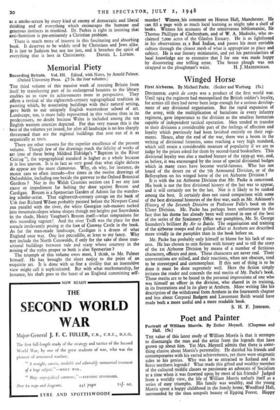Winged Horse
DIVISIONAL esprit de corps was a product of the first world war. Until 1914 the regiment had monopolised the British soldier's loyalty, for armies till then had never been large enough, for a serious develop- ment of any divisional organisation. But the rapid expansion of the army, with the multiplication of battalions in every infantry regiment, gave importance to the division as the smallest formation
capable of independent tactical operation. Men tended to transfer to their divisions a considerable part of the feelings of affection and loyalty which previously had been lavished entirely on their regi- ments. Hence, after the end of the war, there was a boom in the writing of divisional histories, some reaching a very high standard, which still retain a considerable measure of popularity if we are to judge by the prices asked for them by second-hand booksellers. This
divisional loyalty was also a marked feature of the 1939-45 war, and, as before, it was encouraged by the issue of special divisional badges
which in many cases have become world-famous. Who has not heard of the desert rat of the 7th Armoured Division, or of the Bellerophon on his winged horse of the 1st Airborne Division ?
It is with the 1st Airborne Division that Mr. Packe is concerned. His book is not the first divisional history of the last war to appear, and it will certainly not be the last. Nor is it likely to he ranked among the best. It certainly does not stand comparison with some of the best divisional histories of the first war, such as Mr. Atkinson's History of the Seventh Division or Professor Falls's book on the Ulster Division. Mr. Backe has perhaps been unfortunate in the fact that his theme has already been well treated in one of the best of the series of the Stationery Office war pamphlets, Mr. St. George Saunders's brilliant By Air to Battle. The organisation and training of the airborne troops and the gallant affair at Arnhem are described more vividly in the pamphlet than in the book before us.
Mr. Packe has probably only himself to blame for his lack of suc- cess. He has chosen to mix fiction with history and to tell the story of the 1st Airborne Division by means of a number of fictitious characters, officers and, en. These characters are never real. Their conversations are stilte and their reactions, when not obscure, tend . to be stereotyped and commonplace. If this sort of thing is to be done it must be done supremely well. Here the fiction simply irritates the reader and conceals the real merits of Mr. Packe's book. Those merits are to be found in the personal impressions of one who was himself an officer in the division, who shared in its training, in its frustrations and in its glory at Arnhem. More writing like his description of the withdrawal from Arnhem in the fourteenth chapter and less about Corporal Badgem and Lieutenant Reith would have made both a more useful and a more readable book.
S. H. F. JoHNsoN.






































 Previous page
Previous page